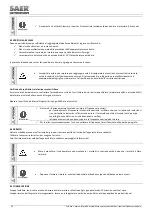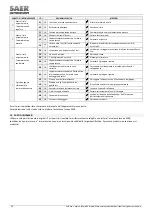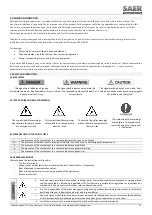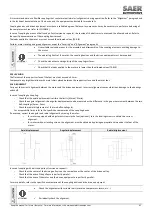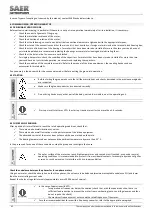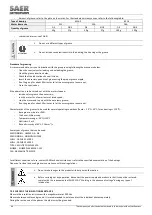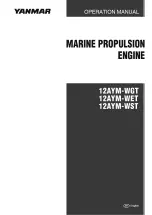
40
The company can alter the data mentioned in this manual without notifications
5.11 ELECTRICAL CONNECTIONS
After checking the data indicated on the plate, proceed with the electrical connection on the panel terminals in compliance with the diagrams,
according to the voltage and the number of phases of the power supply line.
The connections in the terminal board must be tightened with the tightening torques indicated in TAB.V.
The minimum distance between non-insulated parts must be: ≥ 4mm (Un≤440V), ≥ 5,5mm (440<Un≤690V) e ≥ 8mm (690V<Un≤1000V)
·
Make the ground and equipotential connection before all other connections. For the sizing of the ground
cables, refer to TAB. X.
·
Make the connection between the cable and the control panel after installing the unit.
ATTENTION!
ü
Make sure that the terminal box is sealed and protected from ingress of dust and water to ensure the
necessary IP rating. Unused entrances must be closed and sealed.
·
Use a cable with a suitable section according to the length and type of starting. The section of the cable must be
such that:
-
the voltage drop to the motor does not exceed 3%
-
the current density does not exceed the permitted one.
·
Use a cable with copper conductors. Also consider the type of cable depending on the type of application.
·
For the choice of the cable, refer to the international (IEC 60364, NEC Table 310.15(B)(16), AS/NZS 3008) and
local standards in force.
·
Secure the cables to prevent them from being damaged.
·
Do not expose the cables to the sun.
·
Do not bend the cables beyond the minimum bending radius allowed.
5.12 ADJUSTMENT OF PROTECTIONS
Adjustment of protections:
Calibrate the thermal relay of the equipment to the value corresponding to the rated current of the motor and
start it. Slowly reduce the calibration of the thermal protection relay until it trips. Increase the relay setting by 5% and restart the group; if the
relay trips, a further increase of 5% will be necessary, otherwise leave it at the fixed value.
Adjustment of the PT100 probe (optional): refer to the manual of the probe control unit. For motors in insulation class F (155°C), set the alarm
threshold for temperatures not exceeding
130°C.
5.13 CHECK OF THE DIRECTION OF ROTATION
·
In motors operated without couplings the key must be firmly fixed or removed. Coupling devices, if any, must be
properly fastened.
Check the direction of rotation by giving and removing power quickly and observing the cooling fan through the holes in the fan cover.
Checking the direction of rotation - three-phase motors
The correct direction of rotation depends on the characteristics of the driven equipment. If the motor turns in the opposite direction to the
desired one, invert two phases.
Checking the direction of rotation - single-phase motors
The correct direction of rotation depends on the characteristics of the driven equipment.
ATTENTION!
·
Repeat the check each time the motor is disconnected from the power supply.
.
5.14 COUPLING
The coupling devices (couplings, pulleys ...) must be suitable for the application and the type of equipment conducted. Refer to the equipment
manual for more details.

